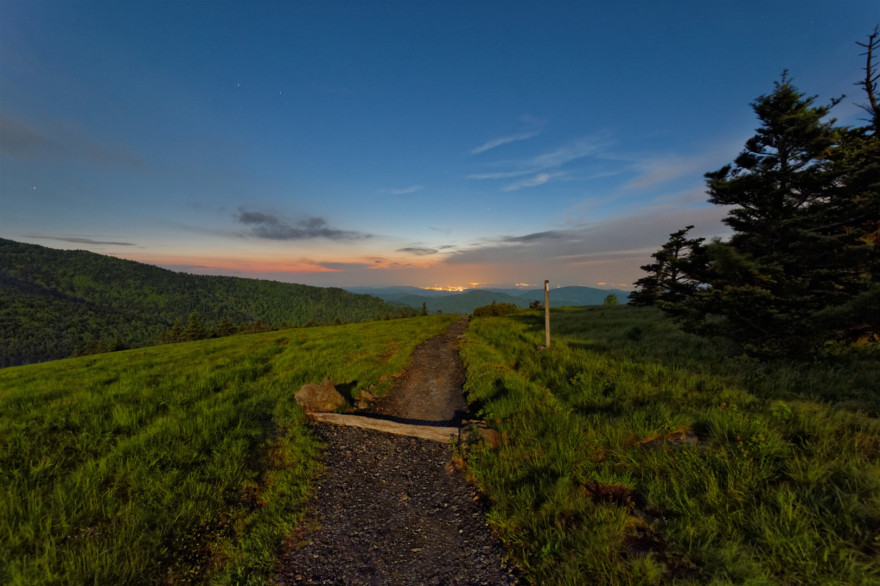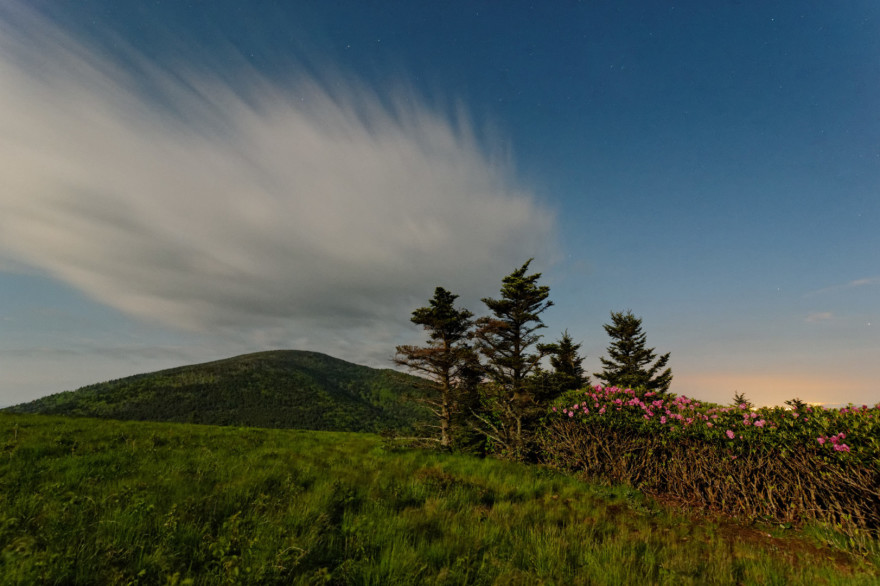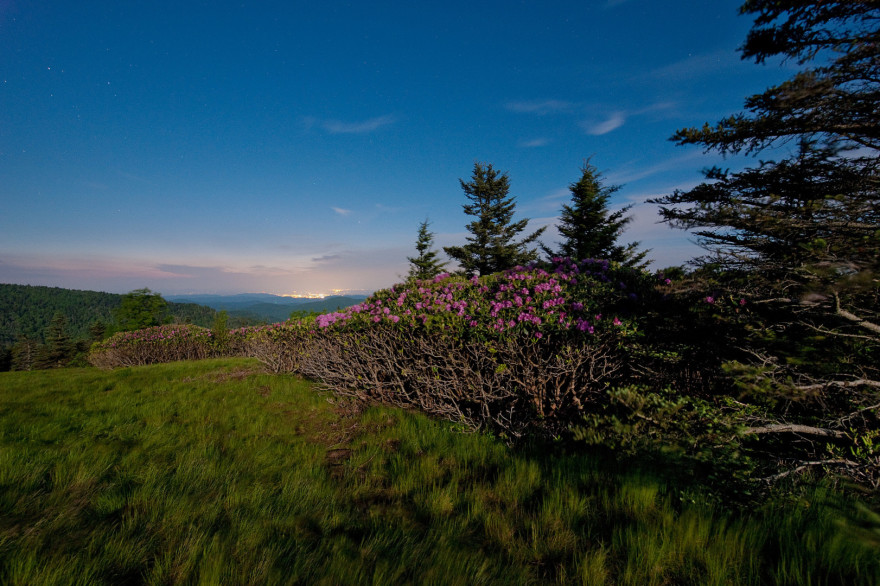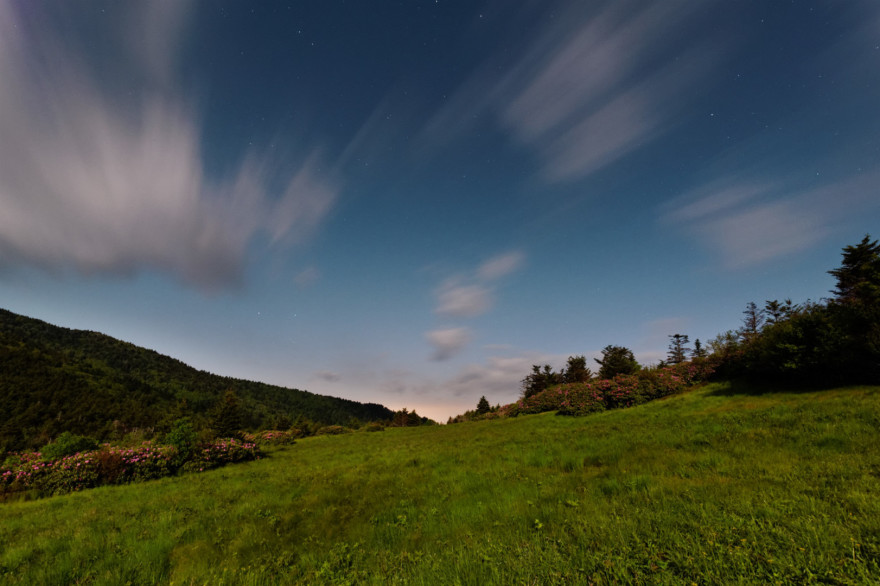



It’s that spectacular time of year when spring breaks out on Appalachian peaks. Catawba Rhododendron, Flame Azalea, bluets, Gray’s Lily, and many other flowering species decorate the highlands. One family tradition, since we live near Roan Mountain, is to do a drive by early in June to see how close to peak the rhododendron flowers are. (And for your information, it looks to me that the peak will be the weekend of June 9 on Roan Mountain and Round Bald.)
Taking pictures in full moonlight has been an interest of mine for a long time. While moonlight is fairly dim for most eyes to see well, it offers enough illumination for photographs. In fact, there is enough light to produce well-lit photos that simulate the appearance of daylight. I tried taking pictures in moonlight with slide film many years ago, but the results were abysmal, with so much film grain that the subject matter was often obfuscated.
I bought my first Nikon D70 digital SLR in 2005, but at least in my hands, it also did a poor job at night. The photos were full of digital noise (akin to film grain) and only mildly improved if I processed raw image files instead of out-of-camera JPEGs. While low light photography worked a little better with each camera upgrade, I was still disappointed, even in Nikon’s recent D300s.
Back in late winter, I upgraded to Nikon’s FX format by buying a used Nikon D700. The D700 has an excellent reputation as a low light camera, boasting results far better than 35mm film and Nikon’s lessor DX format cameras. In a nutshell, FX cameras have image sensors (the digital equivalent of film) more than twice the size of those in DX cameras. Larger sensors equate to greatly increased light gathering capability.
So, whilst on our drive by of the rhododendron Sunday afternoon, realizing it was about time again for a full moon, I thought I might put night photography together with blooming rhododendron and mountains to see if the D700 would live up to its reputation.
I returned to Carver’s Gap shortly after sundown and began my trek up Round Bald. The moon was already up a little ways, nearly if not completely full, big, round, and bright. I could hardly contain my excitement and was a little bit humored by three photographers leaving the bald as I made my way up. I’m sure they got some great full moon rising shots as evening fell, but that was not my plan. With each passing turn in the trail, I made mental notes and calculations—what were the biggest challenges? What ISO should I pick? What’s the longest exposure I can make without getting visible star trails? I observed that the biggest challenge might be the wind. Some gusts were violent and shaking branches and blossoms with gusto; I decided it would just add perhaps a dreamy effect to the photos and resolved not to fight it with higher ISOs. Each ISO stop, while allowing for shorter shutter times, would increase digital noise and lower picture quality. I also thought the west wind might settle as the evening wore on.
But the wind was still a problem at the top of the bald. The gusts were unpredictable and strong enough to topple my tripod—not good while sporting a small fortune in camera and optics perched atop. Thus, good form (stepping away from tripod, using a cable release to minimize vibration to the camera) was exchanged for holding the tripod down with my hands (my body also buffeted by the wind and sometimes shivering). I lowered my expectations for the night’s work and did, in the end, have to cull a few shots lost to camera shake.
I don’t ordinarily include human elements, like trails, in my nature pictures. But that night, a glance backward on the trail was irresistible. I love the look of this photo (see slideshow above); a few faint stars in the sky and the bright city lights below might be the only clues that this picture was taken at night.
Moonlight is very contrasty compared to daylight. The reason is that during the day, shadows are illuminated by the blue sky and clouds. At night, starlight does not fill the shadowy spaces (for human eyes or cameras). My results with the D700 remind me a little bit of Ektachrome slide film, where often shadows would come out really dark.
Carefully plodding down Round Bald, temporarily plunged in darkness for brief intervals as rapidly moving clouds obscured the moon and doused its light, I sought another photo opportunity near Carver’s Gap. By this point, I already knew many of the pictures were coming out well. Modern digital SLRs offer the ability to review shots and zoom in on the built-in LCD display, down to the pixel level, to evaluate focus, blur, and exposure. So while I could have lingered much longer on the mountain, enjoying new lighting opportunities as the moon traced its arc to the west, I wanted to review the results on my workstation before heading to bed.
I came away from this experience very impressed with the Nikon D700. In relative terms, it’s actually a pretty old camera (introduced four years ago in 2008); newer models like Nikon’s D4 and D800 offer even greater promise. But I am delighted to have it; it is the best camera I’ve had the opportunity to use, and it certainly creates possibilities for creativity impossible for me before now.
N.B. Most exposures were around 10 to 20 seconds, f/5.6, ISO 1600. All photos were taken with a Nikon D700 and a Tokina AT-X 16-28 F2.8 PRO FX lens.